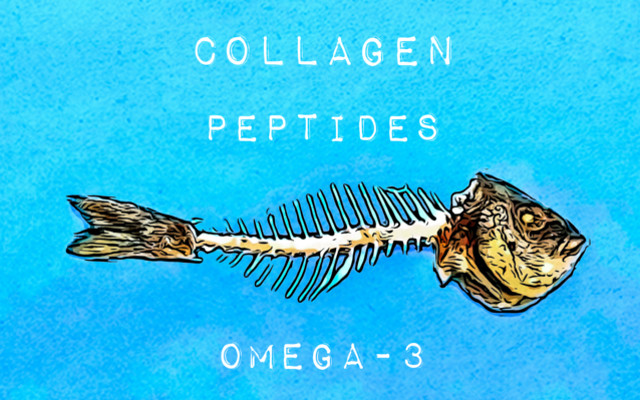Marine collagen is among the most sought after ingredients in food supplements and cosmetics. Its anti-aging benefits on joints and skin are at the center of an experiment conducted within the European EcoeFISHent project, dedicated to the virtuous recovery (upcycling) of co-products (side streams) from the fish supply chain.
Elena Grasselli, head of the Physiology of the Digestive System and Skin research laboratory at the DISTAV department of the University of Genoa, previews at GIFT – Great Italian Food Trade the two ongoing studies on the absorption of collagen at the skin and intestinal level.
Collagen, cellular glue
‘Shredded’ is a protein that contributes to the maintenance of skin and cartilage. With aging, its synthesis decreases, as evidenced by the appearance of wrinkles and osteoarticular pain. The entire human body is covered in collagen, a sort of glue or latex which is found in the extracellular matrix, where the cells are included, and holds the various organs together.
There are at least 29 types of collagen that vary depending on the target organ. That of the skin is type 1, divided into two subtypes (isoforms) which together guarantee the characteristics of the skin organ. The other most common types in food supplements on the market are types 2 and 3, respectively typical of cartilage and muscles.
The sustainability of marine collagen
EcoeFISHent works on a complete marine collagen of all types available, as it is extracted from the skin, viscera, fins and head of fish. Marine collagen has two advantages, as it:
– enhances the co-products of the fishing sector, allowing the use of a large quantity of unused biomass, i.e. 70% of the catch currently not marketed as food,
– it complies with kosher and halal dictates, unlike bovine meat, and can therefore generate greater economic value.
Intestinal absorption of collagen supplements
Scientific literature is unanimous in considering collagen a useful food for the well-being of cartilage. The big question is how much of the collagen ingested through dietary supplements is actually assimilated by the intestine and put into circulation in the body.
Research on a human model will start in 2025 at the laboratory directed by Elena Grasselli, as part of the European EcoeFISHent project.
1.1) A large molecule, difficult to digest
‘Shredded’ is a large molecule composed of three helices, each of 100 kilodaltons (unit of measurement of molecular weight). An element that cannot be digested as is.
‘In the project we will use molecular scissors to break it up and reduce its molecular weight. We will simulate a sort of predigestion of collagen which favors intestinal absorption‘explains Professor Grasselli.
1.2) Which intracellular absorption?
The 300 kilodaltons (the molecular weight) that make up collagen correspond to a word of 3000 letters (amino acids), variously combined with each other.
‘We know that via cell transmission the intestine absorbs a letter or two of 3000. Our goal is to reduce the molecular weight to find out if and how intracellular absorption increases or possibly consider other routes such as the one between one cell and another‘.
1.3) The journey in an artificial intestine
‘Shredded’ collagen will then be digested then be digested by a functioning human intestine model.
‘We use microintestines, i.e. functional tissues made from human intestinal cells. At the base there is an artificial model that perfectly mimics human digestion. It is made up of saliva, gastric fluid, intestinal fluid and intestinal fluid. Then digested it can be incubated with the microintestines. By analyzing each phase we will discover what happens when collagen is ingested and how much goes into circulation‘, says Grasselli.
2) Skin absorption
Cosmetics is the other consolidated use of collagen in an anti-aging key. Professor Grasselli and her team conducted research to measure the skin absorption of marine collagen. The results are very positive and will be published, after review, in open access mode.
‘Marine collagen appears as an aqueous fluid, unsuitable for our experiment. The Ardes cosmetic company (partner in the European EcoeFISHent project) therefore provided us with a version in a cosmetic formulation with a suitable texture and ingredients that promote skin absorption.
The preparation, tested on human skin cells, has proven effective in stimulating the induction of messenger RNA of the two type 1 collagen isoforms present in the skin’explains the researcher.
In other words, the application on artificial skin stimulated the production of endogenous collagen, with an anti-wrinkle, hydrating and elasticising skin effect, thanks to increased water absorption and elastin production.
3) Safety of use
As part of EcoeFISHent, both cosmetic and nutraceutical applications of marine collagen are evaluated from the point of view of safety and regulatory compliance.
Cosmetic applications will be examined for general safety aspects and compliance with good manufacturing practices, thanks to AngelConsulting.
The use of collagen in supplements food will instead be investigated in two macro areas:
– toxicological safety, with analysis of the impact on hepatocytes, liver cells,
– compliance with current rules on food safety and the possible possibility of promoting nutritional & health claims. The latter is an area in which the FARE division of Wiise, a benefit society, publisher of GIFT – Great Italian Food Trade, is involved.
Marta Strinati
Footnotes
(1) Dario Dongo, Andrea Adelmo Della Penna. EcoeFISHent, upcycling and blue economy in the fish supply chain. The EU research project. GIFT (Great Italian Food Trade).
Professional journalist since January 1995, he has worked for newspapers (Il Messaggero, Paese Sera, La Stampa) and periodicals (NumeroUno, Il Salvagente). She is the author of journalistic surveys on food, she has published the book "Reading labels to know what we eat".




